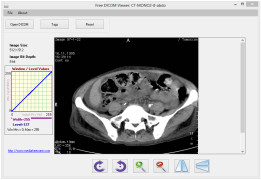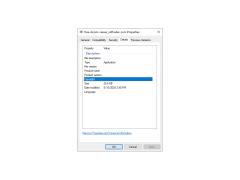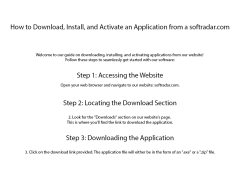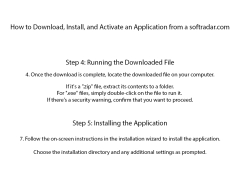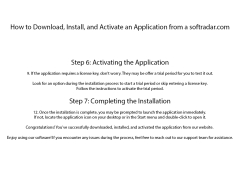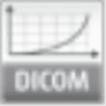
Free DICOM Viewer
by Media Freeware
A free DICOM Viewer software is an application that allows users to view, manipulate, and analyze DICOM (Digital Imaging and Communications in Medicine) files.
Operating system: Windows
Publisher: Media Freeware
Release : Free DICOM Viewer 1.0
Antivirus check: passed
A DICOM Viewer is a software application used to view, manipulate and analyze medical images. It is used by doctors, radiologists, medical researchers, healthcare professionals and medical students to view and analyze medical images such as X-rays, CT scans, MRI scans, Ultrasounds and Nuclear Medicine images in a standardised format.
• Easy-to-use user interface: A DICOM Viewer must be easy to use, with a user interface that is intuitive and uncomplicated. It should be quick and simple to navigate and should allow the user to easily switch between different image views.
• Image adjustment tools: A DICOM Viewer should provide a range of image adjustment tools, such as contrast and brightness adjustment, to help the user interpret the image. It should also be able to invert the image, mirror it and adjust the zoom level.
• Image manipulation tools: A DICOM Viewer should provide a range of image manipulation tools, such as annotation, measurement and colour segmentation, to help the user interpret the image. It should also be able to rotate, flip, crop and resize the image.
• DICOM-compatible: A DICOM Viewer should be DICOM-compatible and should be able to open and view DICOM files in a standardised format. It should also be able to export DICOM files to a variety of image formats, such as JPEG and TIFF.
• Multi-modality support: A DICOM Viewer should be able to view and analyse images from a variety of modalities, such as X-ray, CT, MRI, Ultrasound and Nuclear Medicine.
• Network communication: A DICOM Viewer should be able to communicate over a network, such as the Internet, to allow the user to share images with colleagues, patients and other healthcare professionals.
• Support for third-party systems: A DICOM Viewer should be able to integrate with third-party software and systems, such as PACS and Electronic Health Records (EHRs), to allow the user to share images with other healthcare professionals.
• Security: A DICOM Viewer should provide a secure environment for the user to view and manipulate medical images. It should include features such as user authentication, encryption and data protection.
• Customisable: A DICOM Viewer should be customisable to allow the user to tailor it to their specific needs and preferences. This could include features such as customisable layouts, themes and colour schemes.
• File compatibility: A DICOM Viewer should be able to open and view files from a variety of sources, such as DICOM, JPEG, TIFF and PDF. It should also be able to export files to a variety of image formats.
• Reporting: A DICOM Viewer should be able to generate reports to provide a summary of the images viewed. It should also be able to export these reports to a variety of document formats, such as PDF and Word.
• 3D rendering: A DICOM Viewer should be able to render 3D images to help the user interpret the image. It should also be able to rotate, zoom and pan 3D images to help the user gain a better understanding of the image.
• Print images: A DICOM Viewer should be able to print images to a variety of formats, such as standard paper sizes and film sizes. It should also be able to add annotations and labels to the images when they are printed.
• Help and support: A DICOM Viewer should provide help and support to the user, such as online tutorials, FAQs and user manuals. It should also provide customer support, such as email and telephone support.
A DICOM Viewer is a powerful and versatile tool for viewing and analysing medical images. It has a range of features and tools to help the user interpret and manipulate the images and export them to a variety of formats. It is a must-have for doctors, radiologists, medical researchers, healthcare professionals and medical students.
A free DICOM Viewer allows users to quickly and easily view medical imaging files without any cost.Features:
• Easy-to-use user interface: A DICOM Viewer must be easy to use, with a user interface that is intuitive and uncomplicated. It should be quick and simple to navigate and should allow the user to easily switch between different image views.
• Image adjustment tools: A DICOM Viewer should provide a range of image adjustment tools, such as contrast and brightness adjustment, to help the user interpret the image. It should also be able to invert the image, mirror it and adjust the zoom level.
• Image manipulation tools: A DICOM Viewer should provide a range of image manipulation tools, such as annotation, measurement and colour segmentation, to help the user interpret the image. It should also be able to rotate, flip, crop and resize the image.
• DICOM-compatible: A DICOM Viewer should be DICOM-compatible and should be able to open and view DICOM files in a standardised format. It should also be able to export DICOM files to a variety of image formats, such as JPEG and TIFF.
• Multi-modality support: A DICOM Viewer should be able to view and analyse images from a variety of modalities, such as X-ray, CT, MRI, Ultrasound and Nuclear Medicine.
• Network communication: A DICOM Viewer should be able to communicate over a network, such as the Internet, to allow the user to share images with colleagues, patients and other healthcare professionals.
• Support for third-party systems: A DICOM Viewer should be able to integrate with third-party software and systems, such as PACS and Electronic Health Records (EHRs), to allow the user to share images with other healthcare professionals.
• Security: A DICOM Viewer should provide a secure environment for the user to view and manipulate medical images. It should include features such as user authentication, encryption and data protection.
• Customisable: A DICOM Viewer should be customisable to allow the user to tailor it to their specific needs and preferences. This could include features such as customisable layouts, themes and colour schemes.
• File compatibility: A DICOM Viewer should be able to open and view files from a variety of sources, such as DICOM, JPEG, TIFF and PDF. It should also be able to export files to a variety of image formats.
• Reporting: A DICOM Viewer should be able to generate reports to provide a summary of the images viewed. It should also be able to export these reports to a variety of document formats, such as PDF and Word.
• 3D rendering: A DICOM Viewer should be able to render 3D images to help the user interpret the image. It should also be able to rotate, zoom and pan 3D images to help the user gain a better understanding of the image.
• Print images: A DICOM Viewer should be able to print images to a variety of formats, such as standard paper sizes and film sizes. It should also be able to add annotations and labels to the images when they are printed.
• Help and support: A DICOM Viewer should provide help and support to the user, such as online tutorials, FAQs and user manuals. It should also provide customer support, such as email and telephone support.
A DICOM Viewer is a powerful and versatile tool for viewing and analysing medical images. It has a range of features and tools to help the user interpret and manipulate the images and export them to a variety of formats. It is a must-have for doctors, radiologists, medical researchers, healthcare professionals and medical students.
Minimum systme requirements for a Free DICOM Viewer include:
- A computer with a 1GHz or higher processor
- A minimum of 2GB of RAM
- A minimum of 10GB of available hard disk space
- At least one monitor with a minimun of 1024x768 screen resolution
- A DVD-ROM drive
- A Windows 7 or newer operatign system
- A mouse or compatible pointing device
- An internet connection for aciviating the viewer and downloading updates
- A computer with a 1GHz or higher processor
- A minimum of 2GB of RAM
- A minimum of 10GB of available hard disk space
- At least one monitor with a minimun of 1024x768 screen resolution
- A DVD-ROM drive
- A Windows 7 or newer operatign system
- A mouse or compatible pointing device
- An internet connection for aciviating the viewer and downloading updates
PROS
Allows viewing of DICOM images with adjustable brightness and contrast.
Supports a wide range of medical imaging formats.
Free to download with no hidden costs.
Supports a wide range of medical imaging formats.
Free to download with no hidden costs.
CONS
Limited functionality compared to other DICOM viewers.
May struggle with large file sizes or complex images.
Lacks advanced features for professional medical use.
May struggle with large file sizes or complex images.
Lacks advanced features for professional medical use.
Free DICOM Viewer 1.0
(0.03 MB)
Free DICOM Viewer 1
(1.21 MB)
Andrew G.
This Free DICOM Viewr is great for basic use but it's very limitted when it comes to more advanced featuers which can be a bit of a frustratiom.
Kai N********a
Free DICOM Viewer software is a tool that enables users to view medical images in DICOM format. It is designed to provide easy access to medical images and allows users to analyze and manipulate them for diagnostic purposes. Some of the main features of this software include the ability to display 2D and 3D images, zooming and panning capabilities, measurement tools, and the ability to export images in various formats. It is a useful tool for medical professionals, researchers, and students who need to view and analyze medical images.
Cooper S.
"The Free DICOM Viewer software is easy to use and provides a clear view of medical images."
Arran
Simple to use, supports multiple imaging types.
Harrison
Efficient, intuitive, reliable medical imaging.
Oliver
This medical image viewing software is super practical and easy to use. Its ease of use is due to an intuitive interface that makes navigating between different image views simple. In addition, this tool includes a variety of options for adjusting images, such as contrast and brightness levels, in addition to the ability to reverse, mirror, and zoom the image. It also offers tools for manipulating images, such as annotation, measurement, and color segmentation. This software is compatible with the DICOM format, it can open these files and also export them in JPEG or TIFF format, for example. It also offers a variety of security functions, such as user authentication, encryption, and data protection.


